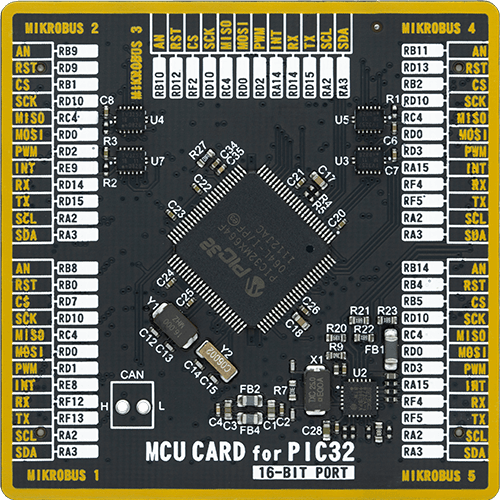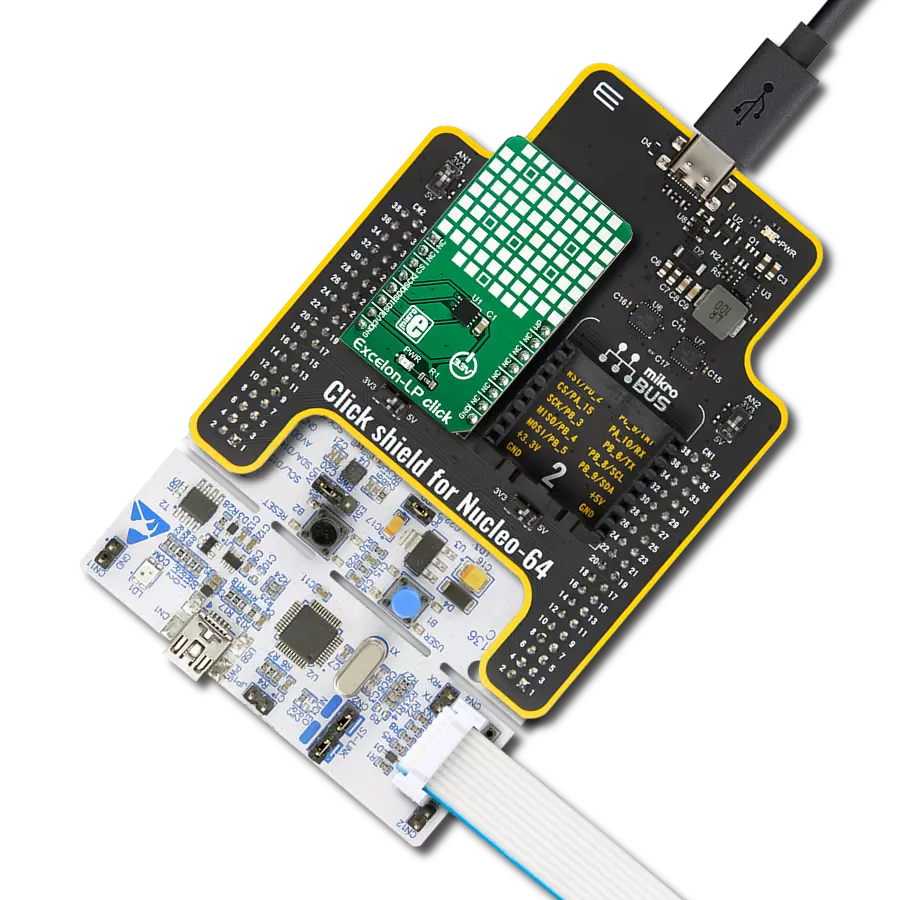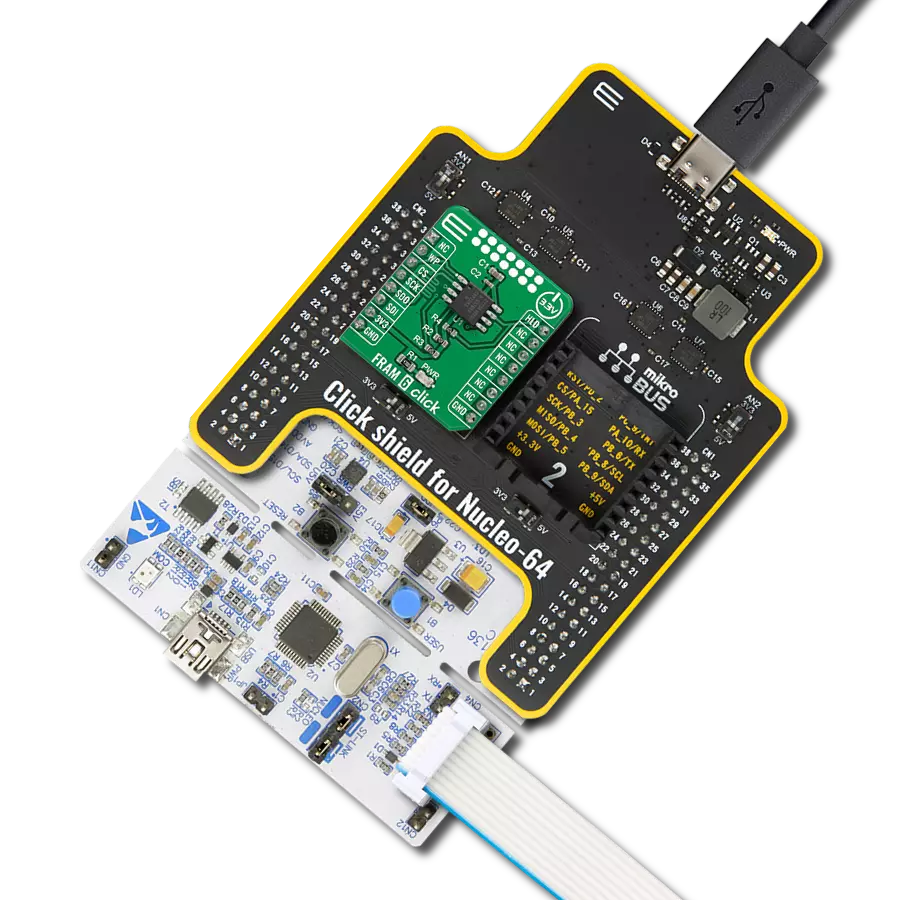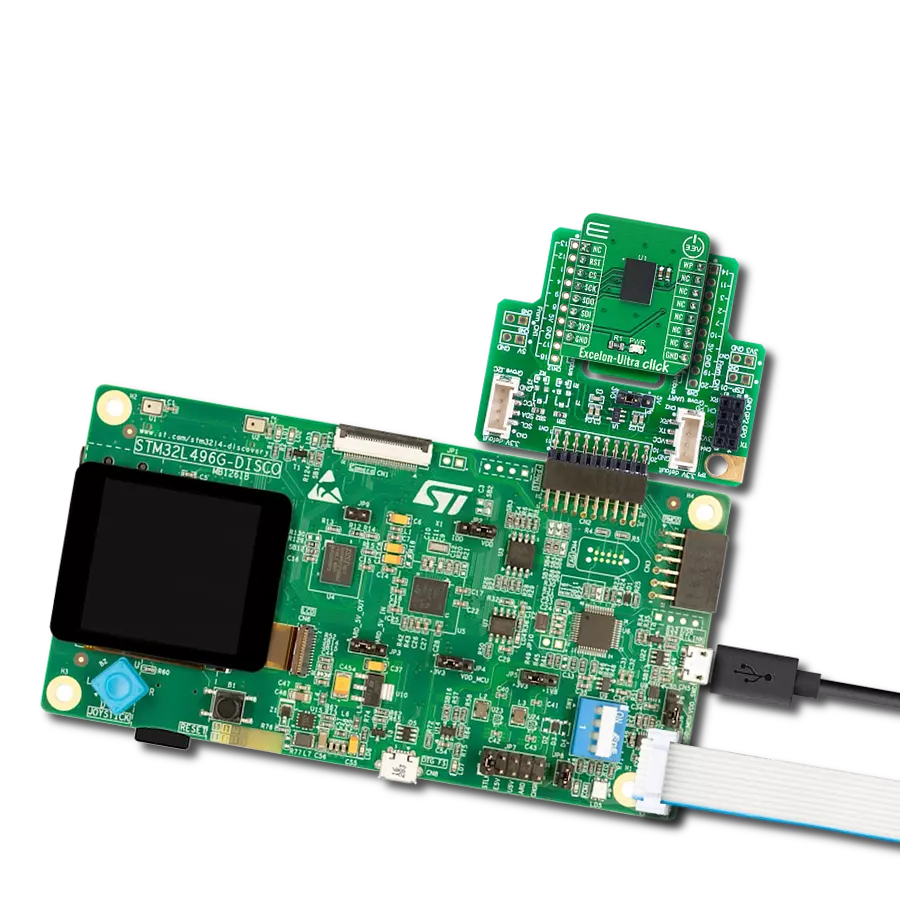Enhance user experiences in consumer electronics by employing FRAM for rapid boot times, seamless application responsiveness, and data retention in power-off states.
A
A
Hardware Overview
How does it work?
Excelon-LP Click is based on the CY15B108Q, a serial ferroelectric (FRAM) module with 8Mbit density made by Infineon. It contains 1024 KB of available memory space. This memory module is manufactured using ferroelectric technology, which has many advantages over conventional technologies for manufacturing conventional EEPROM and FLASH memory modules. Ferroelectric technology is still being developed and perfected, but the main advantages have already been demonstrated. This technology exploits the properties of ferroelectric materials to retain the electric field after exposure, the same way the ferromagnetic materials retain the magnetic field. This phenomenon is employed to polarize the FRAM cells and store the information. One area that still needs improvement is the thermal instability, especially at high temperatures. When the ferroelectric material reaches the Curie temperature, its properties are degraded. Therefore, exposure to high temperatures might damage the content of the FRAM module. This is illustrated by the data retention period in the datasheet: while working at 85˚C, the data retention period is reduced to 10 years. At 65˚C, the data retention period is over 150 years. Still, combined with the endurance of 1014 read/write cycles at bus write speed, this type of memory still represents an ideal solution for applications that must do frequent writing to the non-volatile memory locations. Excelon LP click uses the SPI communication protocol, allowing fast serial clock rates. The device employs certain protection mechanisms to ensure reliable data
transactions and avoid accidental writing to the memory array. The WEL bit must be set before writing any data to the IC, which modifies registers or the array itself. This bit is cleared after or during every memory modification instruction. Therefore, every memory modification instruction must be prefixed with the Write Enable (WREN) instruction that sets this bit to 1. This mechanism ensures that only the intended write instruction will be executed. The host MCU initiates Communication with the device, which drives the chip select pin (#CS on the schematic) to a LOW logic level. This pin is routed to the mikroBUS™ CS pin. The next byte of information can be either command or data. Usually, the first byte is the instruction (command) followed by the memory address. Depending on the command sent, either the memory is written to or read from the specific memory address. The memory address on this device is 20-bit (0x000000 to 0x0FFFFF), and therefore, it is sent by 3 bytes. Several instruction codes can be sent after the CS pin is driven to a LOW logic level. These include Write Enable, Write to the memory array, Read from the memory array, Write Status Register, Read Status Register, and so on. For a full list of commands and their detailed description, please refer to the datasheet of the CY15B108Q IC. When using the write-to-array instruction, it is possible to write the whole array while keeping the CS line to a LOW logic level, as the internal address pointer will increase with each received byte of data once the end of the array is reached (address 0x0FFFFF), the internal pointer will rollover from the beginning
(0x000000). An obvious advantage over the traditional EEPROM can be observed here: on a traditional EEPROM, the memory is organized in pages, usually 256 bytes long, which allows buffering of the data because of the inherently slow write operation. The FRAM memory does not use pages because the memory is written faster than the SPI bus can deliver new information (the data is written at bus speed). Therefore, no buffering is required, and the whole array can be sequentially written. The CY15B108Q includes the option to write-protect specific parts or the whole memory array. The write protection mechanism consists of two bits in the Status Register (BP0, BP1). The Write Status Register instruction can set or reset these bits. BP0 and BP1 bits control the write-protect status of the memory array (from one-quarter to full memory array protection). These bits are non-volatile, and their state is retained between the power cycles. The #WP pin is used to lock the Status Register. When this pin is driven to a LOW level, no further modifications to the Status register are possible, and the instructions used to change bits in this register (Write Enable and Write Status Register) are completely ignored. Driving this pin to a LOW state effectively acts as the hardware memory write-protect lock mechanism. The WPEN bit of the status register can completely turn off this pin: if the WPEN bit is cleared (0), this pin will not affect the CY15B108Q IC. The #WP pin is routed to the mikroBUS™ PWM pin.
Features overview
Development board
Fusion for PIC32 v8 is a development board specially designed for the needs of rapid development of embedded applications. It supports a wide range of Microchip's PIC32 microcontrollers regardless of their number of pins and a broad set of unique functions, such as the first-ever embedded debugger/programmer over WiFi. The development board is well organized and designed so that the end-user has all the necessary elements, such as switches, buttons, indicators, connectors, and others, in one place. Thanks to innovative manufacturing technology, Fusion for PIC32 v8 provides a fluid and immersive working experience, allowing access anywhere and under any circumstances at any time. Each part of the
Fusion for PIC32 v8 development board contains the components necessary for the most efficient operation of the same board. In addition to the advanced integrated CODEGRIP programmer/debugger module, which offers many valuable programming/debugging options and seamless integration with the Mikroe software environment, the board also includes a clean and regulated power supply module for the development board. It can use a wide range of external power sources, including a battery, an external 12V power supply, and a power source via the USB Type-C (USB-C) connector. Communication options such as USB-UART, USB HOST/DEVICE, CAN (on the MCU card, if
supported), and Ethernet is also included. In addition, it also has the well-established mikroBUS™ standard, a standardized socket for the MCU card (SiBRAIN standard), and two display options for the TFT board line of products and character-based LCD. Fusion for PIC32 v8 is an integral part of the Mikroe ecosystem for rapid development. Natively supported by Mikroe software tools, it covers many aspects of prototyping and development thanks to a considerable number of different Click boards™ (over a thousand boards), the number of which is growing every day.
Microcontroller Overview
MCU Card / MCU

Type
8th Generation
Architecture
PIC32
MCU Memory (KB)
64
Silicon Vendor
Microchip
Pin count
100
RAM (Bytes)
32768
Used MCU Pins
mikroBUS™ mapper
Take a closer look
Click board™ Schematic

Step by step
Project assembly
Track your results in real time
Application Output
1. Application Output - In Debug mode, the 'Application Output' window enables real-time data monitoring, offering direct insight into execution results. Ensure proper data display by configuring the environment correctly using the provided tutorial.

2. UART Terminal - Use the UART Terminal to monitor data transmission via a USB to UART converter, allowing direct communication between the Click board™ and your development system. Configure the baud rate and other serial settings according to your project's requirements to ensure proper functionality. For step-by-step setup instructions, refer to the provided tutorial.

3. Plot Output - The Plot feature offers a powerful way to visualize real-time sensor data, enabling trend analysis, debugging, and comparison of multiple data points. To set it up correctly, follow the provided tutorial, which includes a step-by-step example of using the Plot feature to display Click board™ readings. To use the Plot feature in your code, use the function: plot(*insert_graph_name*, variable_name);. This is a general format, and it is up to the user to replace 'insert_graph_name' with the actual graph name and 'variable_name' with the parameter to be displayed.

Software Support
Library Description
This library contains API for Excelon-LP Click driver.
Key functions:
excelonlp_send_command- Functions for send opcode commandexcelonlp_read_data- Functions for read dataexcelonlp_write_memory_data- Functions for write data to memory
Open Source
Code example
The complete application code and a ready-to-use project are available through the NECTO Studio Package Manager for direct installation in the NECTO Studio. The application code can also be found on the MIKROE GitHub account.
/*!
* \file
* \brief ExcelonLP Click example
*
* # Description
* This application writes in RAM memory and read from RAM memory.
*
* The demo application is composed of two sections :
*
* ## Application Init
* Initializes Device init
*
* ## Application Task
* Reads device ID, writes 6-bytes (MikroE) to memory and reads 6-bytes from memory
*
* \author MikroE Team
*
*/
// ------------------------------------------------------------------- INCLUDES
#include "board.h"
#include "log.h"
#include "excelonlp.h"
// ------------------------------------------------------------------ VARIABLES
static excelonlp_t excelonlp;
static log_t logger;
// ------------------------------------------------------ APPLICATION FUNCTIONS
void application_init ( void )
{
uint8_t out_buf[ 20 ] = { 0 };
uint8_t cnt;
log_cfg_t log_cfg;
excelonlp_cfg_t cfg;
/**
* Logger initialization.
* Default baud rate: 115200
* Default log level: LOG_LEVEL_DEBUG
* @note If USB_UART_RX and USB_UART_TX
* are defined as HAL_PIN_NC, you will
* need to define them manually for log to work.
* See @b LOG_MAP_USB_UART macro definition for detailed explanation.
*/
LOG_MAP_USB_UART( log_cfg );
log_init( &logger, &log_cfg );
log_info( &logger, "---- Application Init ----" );
// Click initialization.
excelonlp_cfg_setup( &cfg );
EXCELONLP_MAP_MIKROBUS( cfg, MIKROBUS_1 );
excelonlp_init( &excelonlp, &cfg );
log_printf( &logger, "Read Device ID: " );
excelonlp_send_command( &excelonlp, EXCELONLP_OPCODE_SET_WRITE_ENABLE_LATCH );
excelonlp_read_data( &excelonlp, EXCELONLP_OPCODE_READ_DEVICE_ID, out_buf, 9 );
for ( cnt = 0; cnt < 9; cnt++ )
{
log_printf( &logger, " 0x%x - ", out_buf[ cnt ] );
Delay_100ms();
}
log_printf( &logger, "\r\n" );
}
void application_task ( )
{
uint8_t cnt;
char memory_data[ 3 ];
uint8_t send_buffer[ 7 ] = { 'M', 'i', 'k', 'r', 'o', 'E', 0 };
uint32_t memory_address = 0x00000055;
log_printf( &logger, "Write MikroE data.\r\n" );
excelonlp_send_command( &excelonlp, EXCELONLP_OPCODE_SET_WRITE_ENABLE_LATCH );
for ( cnt = 0; cnt < 6; cnt++ )
{
excelonlp_send_command( &excelonlp, EXCELONLP_OPCODE_SET_WRITE_ENABLE_LATCH );
excelonlp_write_memory_data( &excelonlp, EXCELONLP_OPCODE_WRITE_MEMORY_DATA, memory_address++, send_buffer[ cnt ] );
Delay_100ms();
}
memory_address = 0x00000055;
log_printf( &logger, "Read memory data: " );
for ( cnt = 0; cnt < 6; cnt++ )
{
memory_data[ cnt ] = excelonlp_read_memory_data( &excelonlp, EXCELONLP_OPCODE_READ_MEMORY_DATA, memory_address++ );
log_printf( &logger, " %c", memory_data[ cnt ] );
Delay_100ms();
}
log_printf( &logger, "\r\n \r\n" );
Delay_ms ( 1000 );
Delay_ms ( 1000 );
Delay_ms ( 1000 );
Delay_ms ( 1000 );
Delay_ms ( 1000 );
}
int main ( void )
{
/* Do not remove this line or clock might not be set correctly. */
#ifdef PREINIT_SUPPORTED
preinit();
#endif
application_init( );
for ( ; ; )
{
application_task( );
}
return 0;
}
// ------------------------------------------------------------------------ END
Additional Support
Resources
Category:FRAM

































